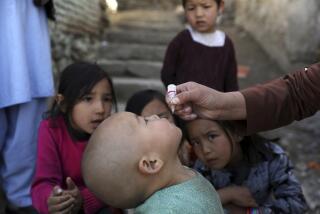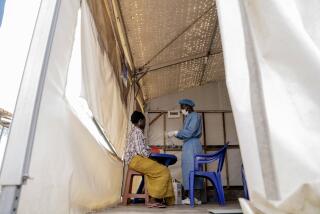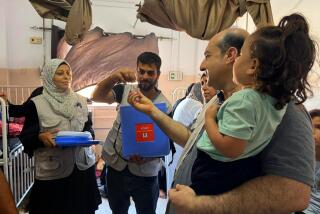Ban Ki-moon: Eradicate polio, finally
As the World Health Assembly convenes in Geneva this week, one item on the agenda will be polio, or more specifically, how to finally deliver on an epic promise made a quarter-century ago: to liberate humankind from one of the world’s most deadly and debilitating diseases.
The world’s war on polio has been as ambitious an undertaking as the successful campaign to eradicate another great public health menace, smallpox. Slowly but surely we have advanced on that goal. Polio, a highly preventable disease, today survives in only three countries: Afghanistan, Nigeria and Pakistan. But there is a looming danger that we could fall victim to our own success.
Here’s why: The world is now populated by a generation that for the most part has never been exposed to polio. Additionally, many in this generation have been inadequately vaccinated. When the virus strikes under those conditions, the impact can be devastating. We saw that in the Republic of Congo and elsewhere in Africa in 2010, when an outbreak killed half of all who contracted the virus. A prompt emergency response by the international community halted the budding epidemic. But the incident gave an idea of the potential consequence of failing to eradicate polio while we have the chance.
This year fewer than 100 people were left paralyzed by polio, almost all of them in the three countries where polio remains entrenched. U.N. epidemiologists warn, however, that a renewed outbreak could cripple as many as 1 million people within the decade, many of them children.
What’s frustrating is that we know how to address this threat. My wife and I have personally immunized toddlers in Asia and Africa, joining tens of millions of government workers, Rotarians, volunteers, political and religious leaders (not to mention parents) who have worked for decades to ensure that every child is protected. Most recently, we visited India, which just two years ago was home to half of all the world’s children with polio. Now, thanks to a concerted drive, we were able to celebrate India’s first polio-free year in history.
Similar efforts are underway in the three remaining polio-endemic countries. President Goodluck Jonathan of Nigeria, Prime Minister Yousuf Raza Gilani of Pakistan and President Hamid Karzai of Afghanistan each personally oversee their national response. Polio eradication in all three countries depends heavily on government resources, but that in itself is not enough. With a determined push, the international community can wipe out polio once and for all. To do so, however, it must organize — and commit the required financial resources.
The United Nations, with its partner Rotary International, is driving the global campaign. Our agencies are working hard to reach all children, including those in refugee camps and those caught up in natural disasters and hunger emergencies.
And we’ve been successful even in extremely tough circumstances. In Somalia, for example, which is afflicted by just about every hardship known to humankind, polio is no longer a threat. Its last case was in 2007, thanks in no small part to local women who donned bright yellow smocks and traveled around their communities distributing vaccination drops.
The workers on the front lines have no shortage of dedication. But that isn’t enough. The Global Polio Eradication Initiative has only half of the $2 billion it needs to procure vaccines and deploy staff to the last outposts of the disease. Investing the rest of the money now would save the world an estimated $40 billion to $50 billion down the road, which would have to be spent on treating outbreaks of the disease and their aftermath.
This week, the world’s health ministers will declare a global public health emergency and call on the world to respond to the threat of a resurgent polio. Let’s heed those calls, so we can make the threat of polio a distant and fading memory.
Ban Ki-moon is secretary-general of the United Nations.
More to Read
Get the L.A. Times Politics newsletter
Deeply reported insights into legislation, politics and policy from Sacramento, Washington and beyond. In your inbox three times per week.
You may occasionally receive promotional content from the Los Angeles Times.










